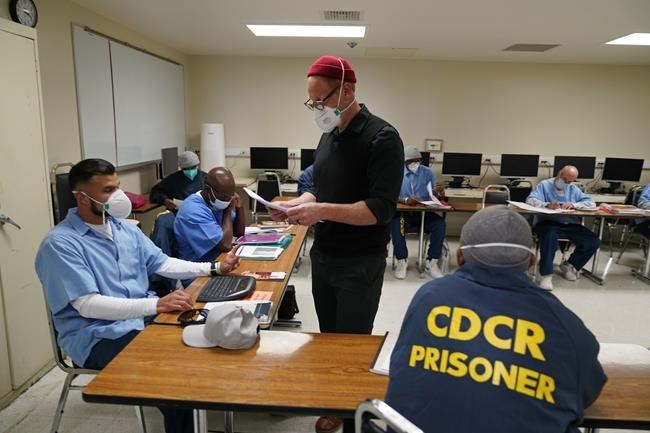SACRAMENTO, Calif. (AP) — The infamous state prison on San Francisco Bay that has been home to the largest death row population in the United States will be transformed into a lockup where less-dangerous prisoners will receive education, training and rehabilitation, California officials announced Thursday.
The nearly 700 inmates serving death sentences at San Quentin State Prison will be moved elsewhere in the California penitentiary system, Gov. Gavin Newsom's office announced, and it will be renamed the San Quentin Rehabilitation Center.
“Today, we take the next step in our pursuit of true rehabilitation, justice, and safer communities through this evidenced-backed investment, creating a new model for safety and justice — the California Model — that will lead the nation,” Newsom said in a statement.
The governor planned a visit Friday to San Quentin, which is also the California location where prisoners were once executed, though none have been put to death since 2006. Newsom announced a moratorium on executions in 2019 and dismantled the prison's gas chamber, and in 2022 he announced plans to begin transferring inmates sentenced to death to other prisons.
Full details of the plan were not immediately made public, though officials said the facility would concentrate on “education, rehabilitation and breaking cycles of crime.” Newsom was expected to share more during his visit, the second stop on a four-day policy tour that he's doing in lieu of a traditional State of the State address this year.
Newsom's office cited as a model Norway’s approach to incarceration, which focuses on preparing people to return to society, as inspiration for the program. Oregon and North Dakota have also taken inspiration from the Scandinavian country's policies.
In maximum-security Norwegian prisons, cells often look more like dorm rooms with additional furniture such as chairs, desks, even TVs, and prisoners have kitchen access and activities like basketball. The nation has a low recidivism rate.
At the overhauled San Quentin, vocational training programs would set people up to land good-paying jobs as plumbers, electricians or truck drivers after they're released, Newsom told the Los Angeles Times.
A group made up public safety experts, crime victims and formerly incarcerated people will advise the state on the transformation. Newsom is allocating $20 million to launch the plan.
Republican Assemblymember Tom Lackey expressed criticism of the plan, saying Newsom and state Democratic lawmakers should spend more time focusing their efforts on supporting the victims of crime.
“Communities win when we have rehabilitative efforts, but yet, how about victims?” Lackey said. “Have we rehabilitated them?”
Meanwhile Taina Vargas, executive director of Initiate Justice Action, an advocacy group based in Los Angeles, said she is pleased the state is moving toward rehabilitating incarcerated people but more drastic changes are needed to transform the criminal justice system that imprisons so many people.
“Over the long term, I think we want to prevent people from going to prison in the first place, which means that we want to offer more opportunities for high paying jobs in the community,” she said.
California voters upheld the death penalty in 2016 and voted to speed up executions. Newsom’s decision to halt them in one of his first major acts as governor drew swift pushback from critics including district attorneys who said he was ignoring the voters.
But Californians have also supported easing certain criminal penalties in an attempt to reduce mass incarceration as part of a more recent movement away from tough-on-crime policies that once dominated the state.
San Quentin is California’s oldest correctional institution, housing one maximum-security cell block, a medium-security dorm and a minimum-security firehouse.
Inmates on death row will not have their sentences changed, but they will be transferred to other facilities, according to Newsom’s office. Today there are 668 inmates serving death sentences in California, almost all of them men, according to the state Department of Corrections and Rehabilitation.
The prison has housed high-profile criminals such as cult leader Charles Manson, convicted murderers and serial killers, and was the site of violent uprisings in the 1960s and 1970s.
But the prison in upscale Marin County north of San Francisco has also been home to some of the most innovative inmate programs in the country, reflecting the politically liberal beliefs of the Bay Area.
Among other such programs, San Quentin houses Mount Tamalpais College, the first accredited junior college in the country based entirely behind bars. The school offers inmates classes in literature, astronomy, U.S. government and others to earn an Associate of Arts degree.
The college’s $5 million annual budget is funded by private donations with volunteer faculty from top nearby universities, including Stanford and the University of California, Berkeley.
___
Sophie Austin is a corps member for the Associated Press/Report for America Statehouse News Initiative. Report for America is a nonprofit national service program that places journalists in local newsrooms to report on undercovered issues. Follow Austin on Twitter: @sophieadanna
Janie Har And Sophie Austin, The Associated Press



